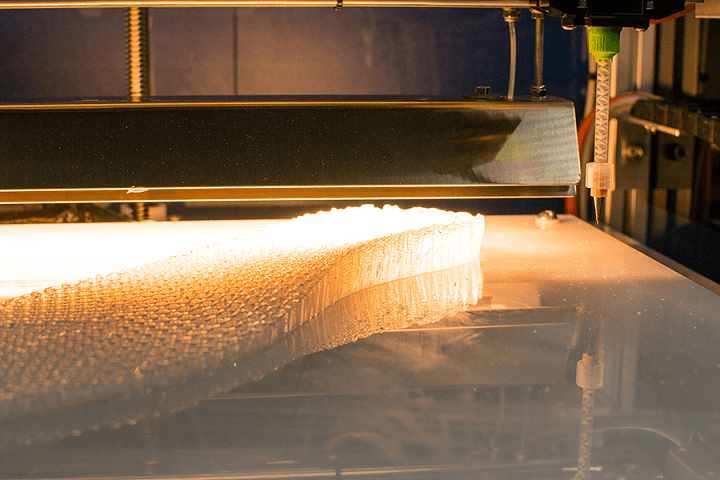German RepRap Introduces New L320 3D Printer for Liquid Additive Manufacturing
 First introduced on the AM trade show circuit in 2017, the unique Liquid Additive Manufacturing (LAM) 3D printing process by industrial 3D printer manufacturer German RepRap works somewhat like FDM, as each layer is extruded and then cross-linked through thermal curing. This can create parts that have very interesting mechanical properties which could allow for many new applications in 3D printing.
First introduced on the AM trade show circuit in 2017, the unique Liquid Additive Manufacturing (LAM) 3D printing process by industrial 3D printer manufacturer German RepRap works somewhat like FDM, as each layer is extruded and then cross-linked through thermal curing. This can create parts that have very interesting mechanical properties which could allow for many new applications in 3D printing.
The company’s LAM technology, developed in partnership with Dow Corning, works with materials that are not melted and then solidified again, as with FFF 3D printing. Instead, the process uses a liquid material, like German RepRap’s customizable polyurethane-based plastic, which is then vulcanized under heat exposure; this is what fully cross-links the individual deposited layers so they are firmly connected.
What also makes LAM such a unique AM process is that it allows for the industrial 3D printing of liquid or high viscosity material, such as Liquid Silicone Rubber (LSR). The company claims that LAM 3D printing can make components with nearly the same properties as injection molded parts, which could prove useful in developing new customer groups that need a more economical method of manufacturing. Especially in flexible materials, this process could see many exciting applications in the medical or footwear arena. Silicone has excellent properties and many firms are very familiar with using it.
This fall, German RepRap presented its LAM process at formnext 2018, along with its first production-ready LAM 3D printer, the L280. The company has been working to further develop the technology for industry use, and is now introducing its new L320 LAM 3D printer, which is an “extremely stable” system, according to German RepRap, that has been “adapted to the high demands of industrial continuous operation.”
With a 250 x 320 x 150 mm build platform and weighing in at approximately 350 kg (without the cartridge system), the L320 features a touchscreen display for intuitive operation, industrial rollers and stand for easy handling, and volumetric extrusion with a lift and sunk system. The printer uses Simplify3D software, and its new printhead technology allows for precise metering and mixing ratios. The nozzle itself would seem to be one by German firm Viscotec but this was not disclosed.
LAM technology makes it possible to influence the application direction, in turn influencing layer-level vulcanization as well. The polymers used in this process have a better molecular structure, as base materials, rather than processed ones, are used. Because insights from 3D printed prototype models can be directly transferred to injection molding, customers benefit from a reduced time-to-market, and the design freedom afforded by 3D printing makes it possible to use cross, lattice, or honeycomb structures to fill parts for better optimization of customized products.
“A high-temperature halogen lamp releases activation energy to accelerate complete crosslinking, at the molecular level. This fine-tuned reaction, in both small and large objects, is ensured by the driving speed of the lamp,” German RepRap explains on its website. “Due to this thermal cross-linking, the printing time is considerably reduced, at the same time the printing result, especially also in terms of time savings, sets new standards.”
 Through extensive testing and pilot applications, the company says that it has proven the reliability of its new L320 3D printer in achieving precise, continuous operation. The printer also features sound safety technology, which monitors the curing process, and the system also registers and displays any deviations; if there are any serious irregularities, the print job will automatically stop.
Through extensive testing and pilot applications, the company says that it has proven the reliability of its new L320 3D printer in achieving precise, continuous operation. The printer also features sound safety technology, which monitors the curing process, and the system also registers and displays any deviations; if there are any serious irregularities, the print job will automatically stop.
To request test prints, or to talk about purchasing the L320 for individual use, email info@germanreprap.com. Commercial users who require high reliability and availability can also get a maintenance contract and professional on-site service from trained German RepRap technicians. This service includes hardware and software training, in addition to maintenance and repair of the L320 itself.
Discuss this story and other 3D printing topics at 3DPrintBoard.com or share your thoughts in the Facebook comments below.
[Images: German RepRap]
The post German RepRap Introduces New L320 3D Printer for Liquid Additive Manufacturing appeared first on 3DPrint.com | The Voice of 3D Printing / Additive Manufacturing.


